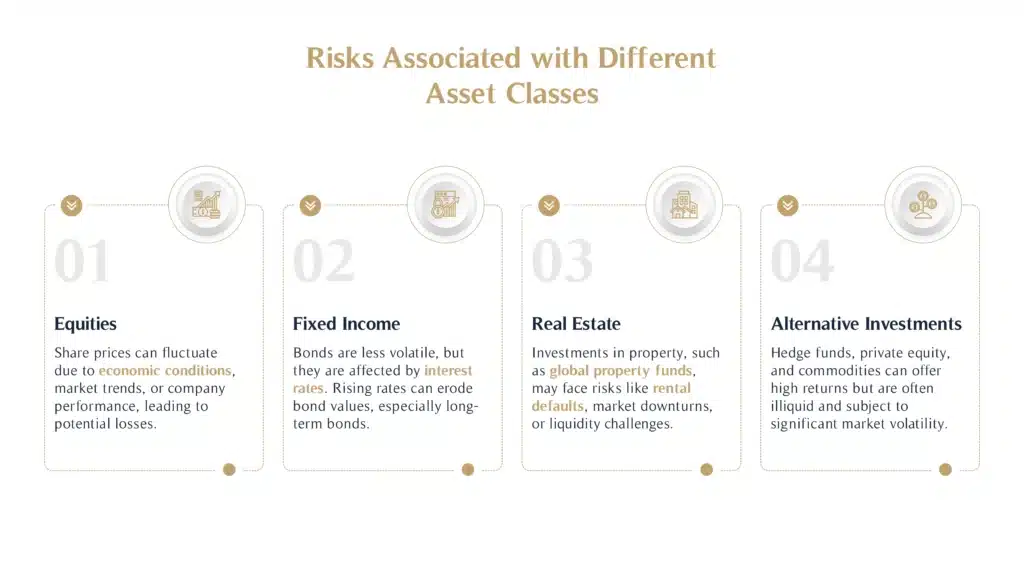A financial asset is a non-physical agreement that gets its value from a contractual claim. This means it shows your ownership of something or your right to payments from it in the future. Financial assets are almost always electronic, and are grouped together into asset classes.
In this guide, we explore what an asset class is, types of asset classes and why they’re useful.
What is an asset class?
An asset class is a group of financial assets that are very similar. They are usually subject to the same laws and regulations, and behave in a similar way.
Each asset class reflects different risk and return characteristics and performs differently in any given market environment – so if you want to invest in assets you probably don’t want to put all your investments into one asset class. A financial advisor will help you diversify your portfolio by combining assets from different classes that might have different cash flow streams and varying degrees of risk.
By investing in several different asset classes, you can maintain the right level of risk and return across your investment portfolio.
Diversification is important to reduce risk and increase your probability of making a good positive return. There is a good summary of what diversification is here.
Types of asset classes
The most common asset classes are:
Cash and cash equivalents
Cash and cash equivalents represent actual cash on hand and securities that behave in a similar way to cash. They are considered very low risk since there is little to no chance of losing your money. However, that peace of mind also means the returns are lower than other asset classes.
Assets in this class include savings accounts, US treasury bills, guaranteed investment certificates (GICs) and money market funds.
Fixed income assets
These are simply any investments that pay a fixed income. In effect, you lend your money to an entity and, in return, they pay you a fixed regular amount until the maturity date – when the loan is paid back to you.
The commonest types are probably government and corporate bonds. The government or company will pay you interest for the life of the loan. The rate depends on things like inflation and perceived risk.
Now, the risk that certain governments will default on their bonds is very low – so they pay out less. However, some companies in riskier, maybe volatile sectors need to pay investors a little more to convince them to part with their money. But the risk is higher.
Equities
This typically means shares in a company. Companies issue shares – or sell slices of ownership – in exchange for the cash they need to invest or grow. Shares are available to the general public, and allows you to profit from the success of a company.
There are two ways you can make money from shares: dividends and selling at a profit. Remember though, markets are volatile and share prices can fluctuate – some companies (even the big ones!) can go bust.
Commodities
Commodities are basic goods that can be transformed into other, more valuable goods and services. So, things like metals, energy resources or agricultural goods.
These are seen as so crucial to the economy, so in some cases they are seen as a good hedge against inflation. The return you get is based on supply and demand dynamics rather than just profitability.
You can invest indirectly in commodities by buying shares in companies that produce them. However, there is also a huge market for investing directly, whether that is actually buying the physical commodity with the view of eventually selling it for a profit or, more likely investing in futures. Futures are financial contracts where you promise to buy an asset at a predetermined price on a specific future date.
Alternative asset classes
Alternative asset classes include tangible property like real estate, and valuable inventory, such as artwork, stamps, and other tradable collectibles (whisky and wine). This can also include hedge funds, venture capital, crowdsourcing or cryptocurrencies.
Traditional asset classes typically form the backbone of most robust investment portfolios. They offer liquidity and are generally well-understood. However, their returns can be less exciting.
The alternative asset classes, on the other hand, are far less liquid and can require longer investment horizons. While these typically attract higher fees and offer less transparency, they can offer potentially higher returns.
Asset Allocation and Risk Tolerance
Asset allocation refers to the process of dividing your investment portfolio among different asset classes such as equities, bonds, real estate, and cash. The goal is to balance risk and reward by aligning your investments with your unique investment goals and financial situation.
But asset allocation isn’t one-size-fits-all. It is heavily influenced by your risk tolerance, your ability and willingness to withstand fluctuations in the value of your investments.
How Risk Tolerance Influences Asset Allocation
Risk tolerance varies from person to person and is often shaped by factors like age, income, financial obligations, and emotional comfort with market volatility.
- Low Risk Tolerance: Investors who prefer safety and stability often lean towards low-risk assets like cash equivalents, government bonds, or liquidity funds. These provide consistent, though modest, returns, making them ideal for short-term goals or those nearing retirement.
- Moderate Risk Tolerance: Those with a balanced approach might opt for a mix of fixed-income investments and multi-asset funds, which offer moderate growth potential with some exposure to market risks.
- High Risk Tolerance: Risk-tolerant investors often focus on higher-return assets like equities, including large-cap, mid-cap, and small-cap stocks, or alternative investments like global property funds. These carry higher risks but also offer the potential for greater company profits over the long term.
Risks Associated with Different Asset Classes
Each asset class comes with its own set of risks:
Examples of Risk Tolerance in Action
Consider these scenarios:
- A 30-year-old saving for retirement in 30 years might allocate a larger portion of his portfolio to equities, taking advantage of his time horizon to weather market fluctuations.
- A 60-year-old nearing retirement may focus on capital preservation, allocating more to fixed-income assets and liquidity funds to ensure stability.
Effective asset allocation helps balance risk and reward, ensuring your portfolio remains aligned with your goals, no matter your risk tolerance.
Investing Across Asset Classes
Investing Through ETFs and Mutual Funds
For those seeking diversification and ease of access, investment funds like exchange-traded funds (ETFs) and mutual funds are excellent options. Both allow you to invest in a basket of securities, spreading risk across multiple asset classes without the need to manage individual investments.
What Are ETFs?
ETFs are funds that trade on stock exchanges, much like individual stocks. They typically track a market index and offer exposure to a wide range of investments, including UK gilt funds, European equity funds, and sector-specific options like commodities or technology.
Advantages of ETFs:
- Liquidity: ETFs can be bought and sold throughout the trading day at market prices.
- Cost-Effectiveness: ETFs generally have lower expense ratios compared to mutual funds.
- Transparency: Holdings are disclosed daily, giving investors clarity on what they own.
What Are Mutual Funds?
Mutual funds pool money from multiple investors to buy a diversified portfolio of assets, managed by a professional. These funds cater to various objectives, from conservative income generation to aggressive growth.
Advantages of Mutual Funds:
- Professional Management: Experienced fund managers make investment decisions on your behalf.
- Customisation: There are funds tailored to different investment goals, such as multi-asset funds or sector-specific options like global property funds.
- Accessibility: Mutual funds are suitable for long-term investors who prioritise steady growth over daily trading.
Key Differences Between ETFs and Mutual Funds:
- Trading: ETFs trade like stocks, while mutual funds are bought or sold at the end-of-day net asset value (NAV).
- Fees: ETFs often have lower management fees, while mutual funds may charge higher fees for active management.
- Flexibility: ETFs are better for short-term trading, whereas mutual funds are ideal for long-term strategies.
Examples of Investing Through ETFs and Mutual Funds:
- If you want exposure to large-cap stocks in Europe, you might choose a European equity fund ETF for lower costs and daily trading flexibility.
- For diversified real estate exposure, a global property fund mutual fund provides professional management and steady income potential.
Both ETFs and mutual funds are effective tools for diversifying your investments across asset classes, helping you achieve a balanced portfolio that aligns with your financial goals.
Conclusion – why are asset classes useful?
MHG Wealth Management certified financial advisors focus on asset classes as a way to help you diversify your portfolios and get the best returns with the lowest risk. Each asset class reflects a different pattern of risk and return, with different investment characteristics. Each performs differently in any given market environment. By sharing investments across a range of different classes when you invest in assets, you can make sure you have the right amount of diversity in your investment selections.
Speaking to one of our market-leading chartered financial advisors can help you determine which asset class to invest in based on your specific goals. Get in touch today to start preparing for your future.






